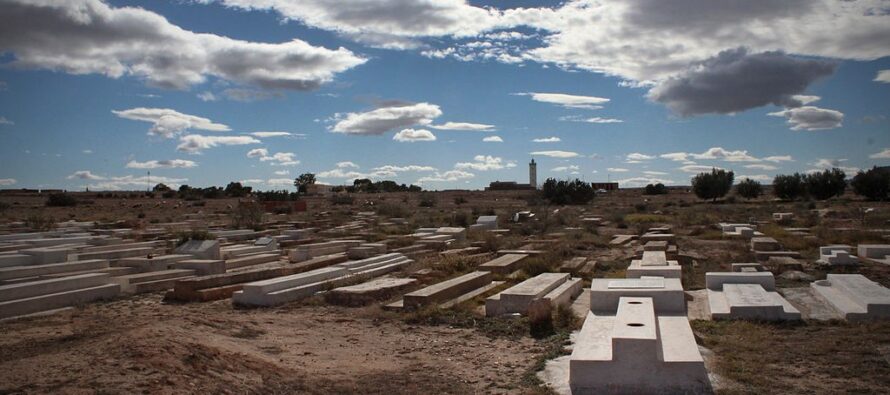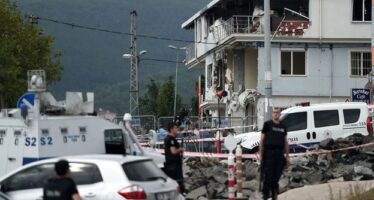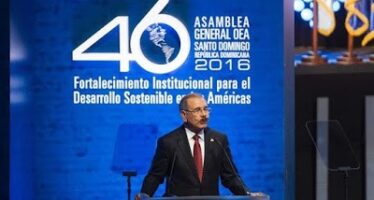Arab Spring 2.0? You ain’t Seen Nothing Yet!

![]()
“We can all derive an important lesson from those events – a non-violent protests in big enough numbers can oust even the most deeply entrenched leader.”
Almost a decade after the launch of the so-called “Arab Spring”, one of the most troubled regions in the entire world remains threatened by the prospects of facing a new wave of protests, demanding regime change due to the ever growing number of problems in such spheres as personal finance, urbanization and unemployment.
Since the original Arab Spring in late 2010, there has been a massive crackdown on protesters in most any country of the region. This trend can be easily observed in various authoritarian tendencies, whether it’s Turkey seeking to remove tens of thousands of civil servants after the 2016 coup attempt, or Saudi Arabia claiming to reform but then arresting its activists and clerics left and right.
This trend is further aggravated by the fact that the Middle Eastern region remains one of the youngest regions on earth, with every second citizen of the 400 million Arab world being younger on average than 25 years old. This becomes yet another major factor in the aggravation of the troubled situation. Therefore, those analysts who claim that the future of the Arab world is in the hands of the young are absolutely right. The question is where they will take it.
However, the demands of the young people are not being met. In a region where a whole new generation is already coming of age almost a decade since the Arab Spring, large numbers of people who were 10 years old during the Tahrir Square protests are now 18 and they continue putting forward their demands that are not being met by their leaders.
These days the “youth factor” inevitably leads to the next phase of the revolutionary movement in the Arab communities. In 2011, the storm waves of the Arab Spring that swept Tunisia, Libya, Egypt, Syria, Yemen and Jordan were nothing but the forerunners of the upcoming change. However, the results of that first wave that protesters managed to secure are nowhere to be seen. If Tunisia managed to avoid a major civil conflict, the revolutionary movements of Syria, Libya and Yemen plunged those states in a bitter civil war that were aggravated by interventions of foreign powers. In Egypt, a year after the events of 2012, military elites came to power, while Jordan managed to avoid violence by containing the Arab Spring on its territory.
According to Turkey’s Daily Sabah, the first mate of World Bank, Mahmud Muhiddin unveiled that the damage resulting from the conflicts in Syria, Libya and Yemen in 2010-2018 reached the disturbing sum of 900 billion dollars.
Although the ongoing mass protests in a number of Arab countries against authoritarianism, corruption and economic problems do not necessarily mean that we can expect a new wave of the “Arab Spring”, we’re facing a volatile situation that can trigger a new wave of regime change movements. A decade ago, the principal driving force behind the Arab Spring protests in the Middle East and North Africa were market changes, economic stagnation and urbanization. These challenges haven’t gone away, as they remain largely unaddressed by the sitting Arab leaders.
In the opening days of April alone two Arab presidents were forced to surrender their posts – Algeria’s Abdelaziz Bouteflika and Sudan’s Omar Hassan Ahmad al-Bashir. The situation in Libya remains highly volatile with the 75-years old Field Marshal Khalifa Belqasim Haftar deciding to follow in the wake of the deceased Muammar Gaddafi with whom he used to be friends at one point.
In general, the second way of the ” Arab spring” is highly reminiscent of the first one, with the demonstrations on the streets of the Sudanese capital being a splitting image of the protests that took place in the Tahrir Square in Cairo a decade ago.
This similarity can be attributed to the fact that the instigators of this recent wave of protests are using the same old tried and tested tactics that triggered the first “Arab Spring”. We’re speaking about provocative publications in social media that demand a change or else. But we can all derive an important lesson from those events – a non-violent protests in big enough numbers can oust even the most deeply entrenched leader.
The renewed unrest across North Africa has also underscored the fact that the fundamental problems that exploded into the earlier uprisings have continued to go unaddressed, including soaring populations of disaffected young people, closed and corrupt economies unable to absorb job seekers and authoritarian governments that remain unresponsive to the demands of the general public.
Against this backdrop the figure of the 64 years old Egyptian leader Abdel Fattah el-Sisi becomes even more intriguing, as he comes to Washington to seek at least a tacit blessing ahead of a referendum to change the Egyptian constitution so that he can stay in power until 2034 — in effect, to remain president for life.
However, it remains unclear how common Egyptians are going to take a national equivalent of the Algerian or Sudanese “old-timer ” commanding them on their path forward. It’s true that so far Sisi has managed to suppress dissident voices, but just for how long will he be able to carry on doing that?
One cannot rule out the possibility that Egypt will find itself at the tip of yet another revolutionary wave. Those implications are getting even more serious if one is to take a look at Sisi’s decision to cut down on the hydrocarbon subsidies provided to the general population of the country against the backdrop of high unemployment rates and uncontested inflation.
It’s particularly curious that a new wave of protest movements across Egypt can be triggered by outside players should Abdel Fattah el-Sisi disagree with Washington over some major matter. This means that his government continues to operate over a barrel of Western monopolies, with people like Philip Gordon, who used to occupy the position of the White House Special Assistant to the President and White House Coordinator for the Middle East, North Africa, and the Persian Gulf Region under Barack Obama continue to argue that massive public unrest movements in such states as Egypt and Sudan are inevitable as they remain, he argues, nothing but a matter of time.
It is noteworthy that those actors behind provocative publications in social networks have been paying an ever increasing amount of attention to proceed with their subversive activities among the military cadre, as it has become evident from the recent events in such countries as Sudan and Algeria that servicemen play an important role in local events. However, those processes are being deterred by the fact that the authority of armed forces in Arab countries remains at a rather high level, as local servicemen are generally considered less corrupt and unable to impact the overall country’s economy, which works in their favor. Hence they cannot bear full responsibility for the deterioration of the economic and social situation in the absolute majority of the countries of the region.
To make the matter worse, on top of the countries already mentioned above, in the near future we can expect an expansion of protest movements. In particular, such monarchies as Morocco and Jordan may found themselves being caught with their pants down, as all sorts of actors carry on their attempts to instigate protests in their capitals. And a number of analysts that continue to argue that direct heirs of the prophet Muhammad cannot be treated in just the same manner as other individuals cannot be any further from truth, as they can be taken down just as easily.
At this point it feels like the next wave of color revolution protests are just around the corner. They can, once again, shake the very foundation of the Middle East and North Africa, leaving formerly rich countries in ruin. Over the past decade, the Arab world has survived a number of revolutionary transformations, and now, if there is no visible improvement in the standard of living of the local population, most any government of the region can start seeing the writings on the wall. Certainly, they wouldn’t appear there without the direct participation of Washington that has been seeking to redraw the regional map completely for a number of decades.
* By Jean Périer – Source New Eastern Outlook
Republishing of this article is welcomed with reference to NEO.
https://journal-neo.org/2019/05/27/arab-spring-2-0-you-aint-seen-nothing-yet/
Image
Mohamed Bouazizi’s grave and tombstone
Tarek al-Tayeb Mohamed Bouazizi (Arabic: محمد البوعزيزي; 29 March 1984 – 4 January 2011) was a Tunisian street vendor who set himself on fire on 17 December 2010, in protest of the confiscation of his wares and the harassment and humiliation that he reported was inflicted on him by a municipal official and her aides. His act became a catalyst for the Tunisian Revolution and the wider Arab Spring, inciting demonstrations and riots throughout Tunisia in protest of social and political issues in the country. The public’s anger and violence intensified following Bouazizi’s death, leading then-President Zine El Abidine Ben Ali to step down on 14 January 2011, after 23 years in power. The success of the Tunisian protests inspired protests in several other Arab countries, plus several non-Arab countries. The protests included several men who emulated Bouazizi’s act of self-immolation, in an attempt to bring an end to their own autocratic governments. Those men and Bouazizi were hailed by Arab commentators as “heroic martyrs of a new Middle Eastern revolution”. In 2011, Bouazizi was posthumously awarded the Sakharov Prize jointly along with four others for his and their contributions to “historic changes in the Arab world”. The Tunisian government honored him with a postage stamp. The Times of the United Kingdom named Bouazizi as “Person of 2011”.
By Thijs Roes [CC BY-SA 4.0 (https://creativecommons.org/licenses/by-sa/4.0)]
Related Articles
Turkey attacks: Deadly violence in Istanbul and Sirnak
![]()
A wave of violent attacks hit Turkey on Monday, with five members of the security forces killed in the south-east and a bomb blast in Istanbul.
OEA: adoptada tímida resolución de desagravio a República Dominicana con relación a invasión de 1965
![]()
Durante la sesión de inauguración de la Asamblea General de la Organización de Estados Americanos realizada el pasado Lunes 13 de junio del 2016, en Santo Domingo, el Presidente Danilo Medina de República Dominicana sorprendió a algunos en su discurso de bienvenida
La piña de Costa Rica ante la Comisión Interamericana de Derechos Humanos
![]()
Este 20 de marzo del 2015, la Comisión Interamericana de Derechos Humanos celebra una audiencia para escuchar los alegatos de comunidades de Costa Rica víctimas de los efectos de la producción de la piña





